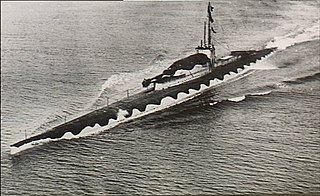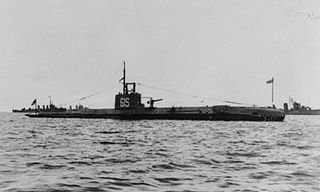
K-141 Kursk was an Oscar II-class nuclear-powered cruise missile submarine of the Russian Navy.

Portland Harbour is located beside the Isle of Portland, Dorset, on the south coast of England. Construction of the harbour began in 1849; when completed in 1872, its 520-hectare (1,300-acre) surface area made it the largest man-made harbour in the world, and remains one of the largest in the world today. It is naturally protected by Portland to the south, Chesil Beach to the west and mainland Dorset to the north. It consists of four breakwaters — two southern and two northern. These have a total length of 4.57 km and enclose approximately 1,000 hectares of water.

HMS A1 was the Royal Navy's first British-designed submarine, and their first to suffer fatal casualties.

HMS A3 was an A-class submarine built for the Royal Navy in the first decade of the 20th century. She sank in 1912. The wreck is a Protected Wreck managed by Historic England.

The British Royal Navy M-class submarines were a small class of diesel-electric submarines built during World War I. The unique feature of the class design was a 12-inch (305 mm) gun mounted in a casemate forward of the conning tower.
High-test peroxide (HTP) is a highly concentrated solution of hydrogen peroxide, with the remainder consisting predominantly of water. In contact with a catalyst, it decomposes into a high-temperature mixture of steam and oxygen, with no remaining liquid water. It was used as a propellant of HTP rockets and torpedoes, and has been used for high-performance vernier engines.

The two Explorer-class submarines were experimental vessels built for the Royal Navy to test a propulsion system based on the use of highly concentrated hydrogen peroxide and diesel fuel to achieve high underwater endurance and speeds.

HMS Maidstone was a submarine depot ship of the Royal Navy. It operated in the Mediterranean Sea, Indian Ocean and Pacific Ocean during the Second World War. It was later used as a barracks ship and then a prison ship in Northern Ireland.

The nuclear-powered Project 949A Antey submarine Kursk sank in an accident on 12 August 2000 in the Barents Sea, during the first major Russian naval exercise in more than 10 years, and all 118 personnel on board were killed. The crews of nearby ships felt the initial explosion and a second, much larger, explosion, but the Russian Navy did not realise that an accident had occurred and did not initiate a search for the sub for more than six hours. The submarine's emergency rescue buoy had been intentionally disabled during an earlier mission and it took more than 16 hours to locate the sunken boat.

Britain's commando frogman force is now the Special Boat Service (SBS), whose members are drawn largely from the Royal Marines. They perform various operations on land as well as in the water. Until the late 1990s, all members of the Special Air Service (SAS) Boat Troop were trained as commando frogmen.

HMS Swordfish (61S) was a first-batch S-class submarine built for the Royal Navy during the 1930s. Commissioned in 1932, she was given the pennant number 61S and was assigned to the 2nd Submarine Flotilla.
HMS L24 was a L-class submarine built for the Royal Navy during World War I. The boat was not completed before the end of the war and was sunk in an accidental collision in 1924.
There have been several British 21-inch (533 mm) torpedoes used by the Royal Navy since their first development just before the First World War.

HMS M2 was a Royal Navy submarine monitor completed in 1919, converted in 1927 into a submarine aircraft carrier. She was wrecked in Lyme Bay, Dorset, Britain, on 26 January 1932. She was one of three M-class boats completed.

Royal Naval Cemetery is a cemetery on the Isle of Portland, Dorset, England. The site overlooks Portland Harbour, and is found below the main entrance to the Verne Citadel. As the name suggests, the graveyard holds deceased servicemen and officers of Portland's Royal Navy which was stationed at the island until 1995. The cemetery holds 140 identified casualties in total to date, and is owned by the Ministry of Defence.

The Portland Cenotaph is a war memorial located on the Isle of Portland, Dorset, England. It is situated at New Ground, looking down to Underhill of the island and overlooking Chesil Beach, as it stands in front of Portland Heights Hotel. The monument is dedicated to the local soldiers who died during both the First and Second World Wars. It has been a Grade II Listed Monument since May 1993.
SS Binnendijk was a Dutch steel cargo ship lost off Portland Bill in the English Channel in 1939. The ship has become locally known as 'The Benny' and its wreck remains a dive site.
The following index is provided as an overview of and topical guide to Wikipedia's articles on recreational dive sites. The level of coverage may vary:

Recreational dive sites are specific places that recreational scuba divers go to enjoy the underwater environment or for training purposes. They include technical diving sites beyond the range generally accepted for recreational diving. In this context all diving done for recreational purposes is included. Professional diving tends to be done where the job is, and with the exception of diver training and leading groups of recreational divers, does not generally occur at specific sites chosen for their easy access, pleasant conditions or interesting features.
















